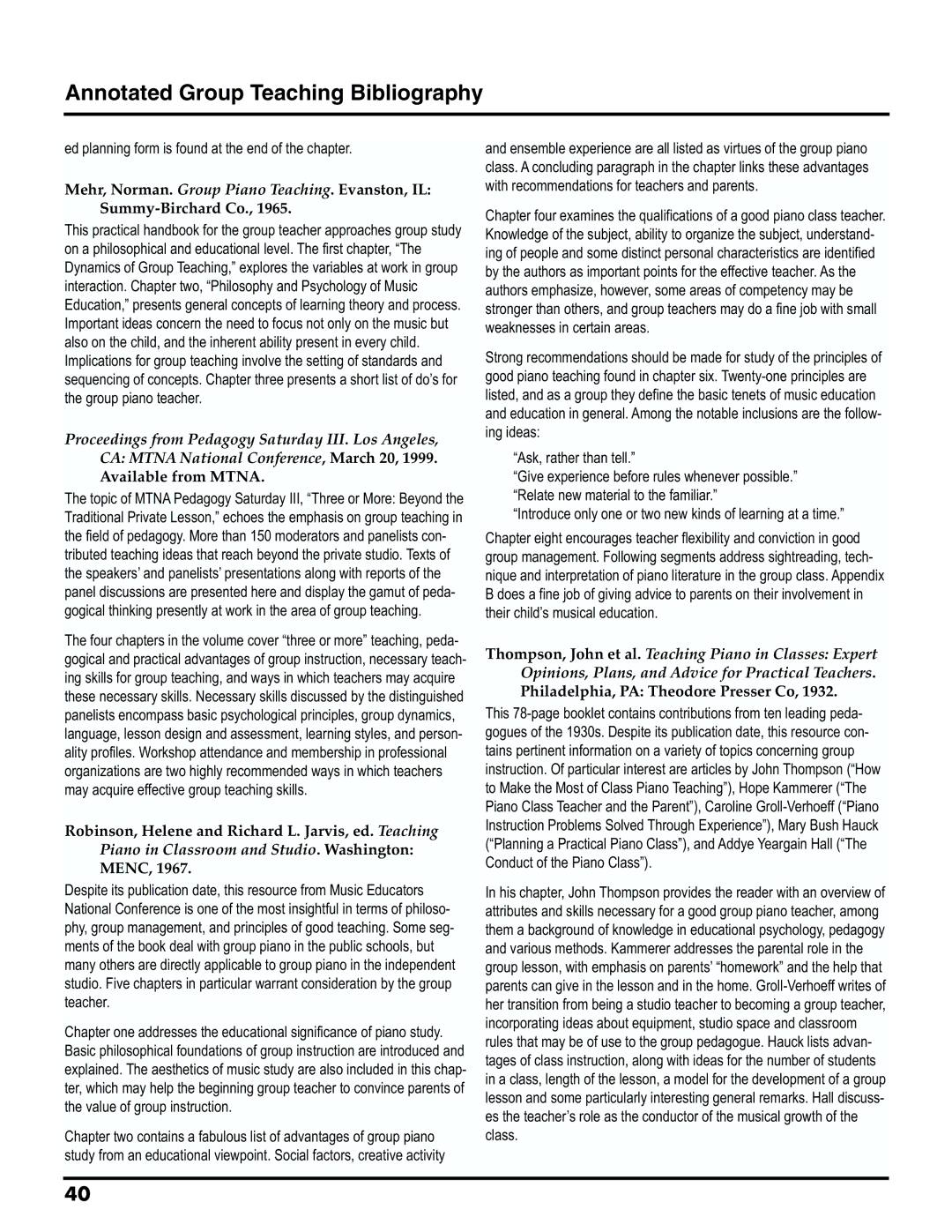
Annotated Group Teaching Bibliography
ed planning form is found at the end of the chapter.
Mehr, Norman. Group Piano Teaching. Evanston, IL:
This practical handbook for the group teacher approaches group study on a philosophical and educational level. The first chapter, “The Dynamics of Group Teaching,” explores the variables at work in group interaction. Chapter two, “Philosophy and Psychology of Music Education,” presents general concepts of learning theory and process. Important ideas concern the need to focus not only on the music but also on the child, and the inherent ability present in every child. Implications for group teaching involve the setting of standards and sequencing of concepts. Chapter three presents a short list of do’s for the group piano teacher.
Proceedings from Pedagogy Saturday III. Los Angeles, CA: MTNA National Conference, March 20, 1999. Available from MTNA.
The topic of MTNA Pedagogy Saturday III, “Three or More: Beyond the Traditional Private Lesson,” echoes the emphasis on group teaching in the field of pedagogy. More than 150 moderators and panelists con- tributed teaching ideas that reach beyond the private studio. Texts of the speakers’ and panelists’ presentations along with reports of the panel discussions are presented here and display the gamut of peda- gogical thinking presently at work in the area of group teaching.
The four chapters in the volume cover “three or more” teaching, peda- gogical and practical advantages of group instruction, necessary teach- ing skills for group teaching, and ways in which teachers may acquire these necessary skills. Necessary skills discussed by the distinguished panelists encompass basic psychological principles, group dynamics, language, lesson design and assessment, learning styles, and person- ality profiles. Workshop attendance and membership in professional organizations are two highly recommended ways in which teachers may acquire effective group teaching skills.
Robinson, Helene and Richard L. Jarvis, ed. Teaching Piano in Classroom and Studio. Washington: MENC, 1967.
Despite its publication date, this resource from Music Educators National Conference is one of the most insightful in terms of philoso- phy, group management, and principles of good teaching. Some seg- ments of the book deal with group piano in the public schools, but many others are directly applicable to group piano in the independent studio. Five chapters in particular warrant consideration by the group teacher.
Chapter one addresses the educational significance of piano study. Basic philosophical foundations of group instruction are introduced and explained. The aesthetics of music study are also included in this chap- ter, which may help the beginning group teacher to convince parents of the value of group instruction.
Chapter two contains a fabulous list of advantages of group piano study from an educational viewpoint. Social factors, creative activity
and ensemble experience are all listed as virtues of the group piano class. A concluding paragraph in the chapter links these advantages with recommendations for teachers and parents.
Chapter four examines the qualifications of a good piano class teacher. Knowledge of the subject, ability to organize the subject, understand- ing of people and some distinct personal characteristics are identified by the authors as important points for the effective teacher. As the authors emphasize, however, some areas of competency may be stronger than others, and group teachers may do a fine job with small weaknesses in certain areas.
Strong recommendations should be made for study of the principles of good piano teaching found in chapter six.
“Ask, rather than tell.”
“Give experience before rules whenever possible.” “Relate new material to the familiar.”
“Introduce only one or two new kinds of learning at a time.”
Chapter eight encourages teacher flexibility and conviction in good group management. Following segments address sightreading, tech- nique and interpretation of piano literature in the group class. Appendix B does a fine job of giving advice to parents on their involvement in their child’s musical education.
Thompson, John et al. Teaching Piano in Classes: Expert Opinions, Plans, and Advice for Practical Teachers. Philadelphia, PA: Theodore Presser Co, 1932.
This
In his chapter, John Thompson provides the reader with an overview of attributes and skills necessary for a good group piano teacher, among them a background of knowledge in educational psychology, pedagogy and various methods. Kammerer addresses the parental role in the group lesson, with emphasis on parents’ “homework” and the help that parents can give in the lesson and in the home.
40
